11 email subject line best practices: use personalisation and AI to increase open rate
It’s no secret—email is one of the most powerful marketing tools. That’s because, along with SMS, it’s one of the only channels you truly own—everything else is just rented.
The ability to reach your audience directly without social algorithms and higher conversion rates compared to ads make email a go-to channel for every marketer. But now that the average marketing team knows that, it’s become harder for businesses to stand out in a crowded inbox.
In the inbox, the subject line is your first impression—it’s how you create intrigue and make shoppers want to pay attention to what you have to say.
In fact, creating a compelling email marketing subject line could be the difference between someone opening your email and converting vs. scrolling right past your brand’s name.
But here’s when things get tricky: there’s no secret formula for crafting effective subject lines.
The good news is that data, best practices, and tests can help you understand what works best for your target audience.
Klaviyo’s business intelligence team studied over 630K email marketing campaigns sent from accounts in English-speaking countries in 2022.
Accounts included both small-midsized businesses (brands with email list sizes between 10K and 300K) and mid-market businesses (those with list sizes between 200K and 3M).
We set out to understand:
- How to best use emojis in subject lines
- How long subject lines should be for the highest open rates
- How to write personalised email subject lines
- When (and whether) to use all caps
- How (and whether) to use punctuation marks
Keep reading for:
- 12 best practices for email subject lines
- 11 great email subject line examples (and why they work)
- Klaviyo’s AI-powered subject line assistant: let us do the work for you
- Ready to stand out with email subject lines that earn clicks?
9 tips for creating the best email subject lines
The best way to come up with ideas for email subject lines with high click rates is to check out some top examples and analyse the patterns that emerge.
Here are 13 email data-backed best practices for email subject lines that will make subscribers want to open—and read—your emails.
1. Personalise your email subject lines
Our research shows that personalisation in subject lines is rare, despite the fact that it helps increase open rates.
Generally speaking, the larger the company, the more likely they are to use personalisation. Mid-market companies tend to use personalisation in subject lines in 3.2% of their emails, while small-midsized businesses only use personalisation in 2.7% of their emails.
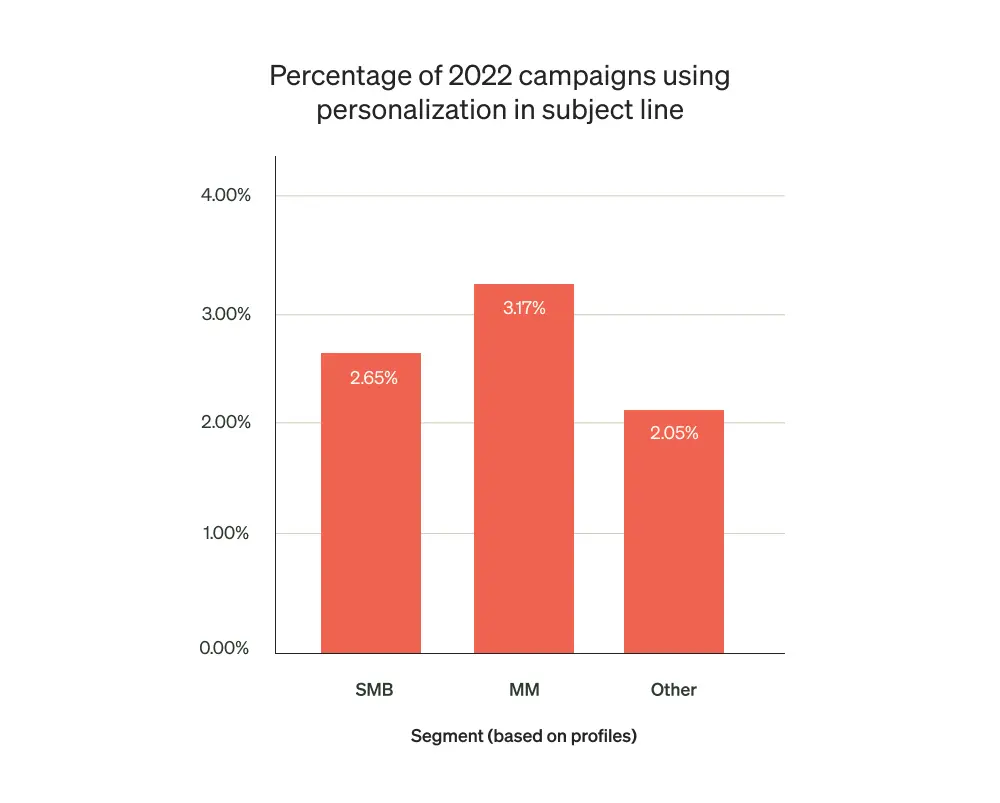
Most of the time, “personalisation” in a subject line means simply using the reader’s first name.
According to our recent data, open rates with the recipient’s name in the email subject line have an 8.92% open rate, compared to an 8.64% open rate for subject lines without a name for small-midsized businesses.
Mid-market sized companies tend to use email recipient names at a higher percentage.
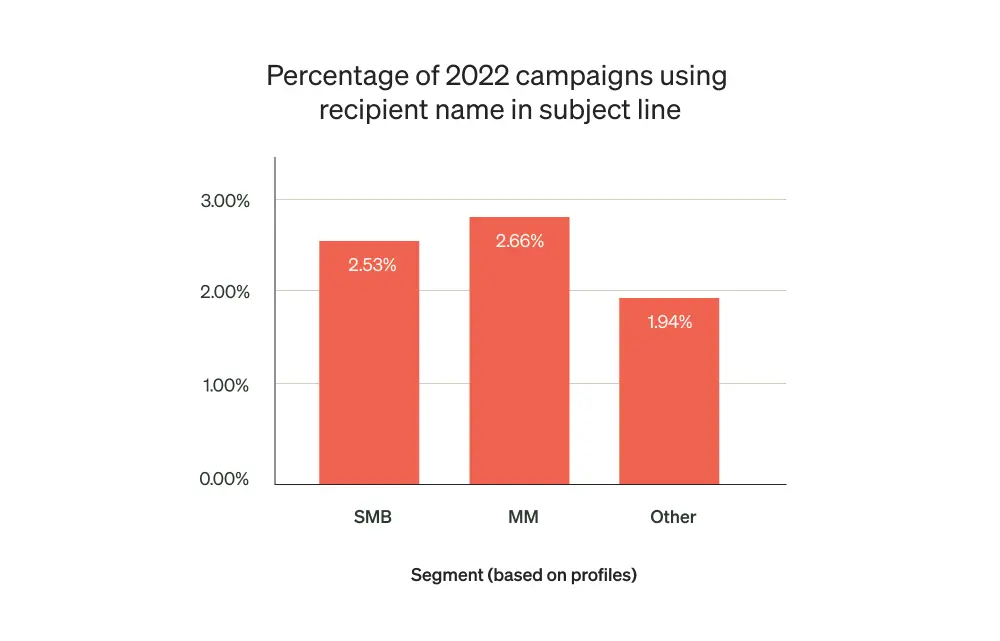
But personalisation doesn’t have to stop there.
Collecting data with the knowledge, permission, and explicit consent of your prospects and customers will put you ahead of the competition by opening endless personalisation opportunities. This is why it’s increasingly important to collect Customer-First Data™ that helps you create a personalised shopping experience.
Morgan Mulloy, associate director of retention marketing at Avex Designs, emphasises the importance of personalisation. “Make sure your email subject line is relevant to your target audience. The terminology you use should appeal to that specific audience.”
You can also personalise your email content based on comprehensive event data such as:
- Recently viewed products
- Items ordered
- Abandoned carts
- Most viewed products
Personalising with segmentation
Clothing brand Jenni Kayne uses the subject line to show that the content of the email is personalised. By referencing products, the shopper has viewed and bought before. “Your favourites have returned,” it reads.
Personalisation in an email like this taps into customer data around individuals’ product preferences and it is likely to make the shopper feel seen and known.
While the subject line itself could be further personalised—”Cindy, the sweater you were eyeing is back in stock”—Jenni Kayne’s example is a good nod to the personalisation within the email.

In order to properly personalise your emails and subject lines, segmentation is crucial. Your customers are unique, and are attracted to different products and services.
Segmenting via engagement levels can help you use your marketing resources more efficiently and effectively. It’s also proven to increase ROI and improve sender reputation and deliverability.
Once you’ve started segmenting, you can begin A/B testing out different subject lines with different demographics.
Nichelle Hubley, founder and CEO of &BAM, says “Different segments respond to different kinds of subject lines. Run some tests to see what segments respond best to FOMO, curiosity, self-interest, etc. Your customers and pre-customers will open based on where they are in their buyer’s journey, so think “who,” not “what.”
Your customers and pre-customers will open based on where they are in their buyer’s journey, so think ‘who,’ not ‘what.’
Personalising with dynamic variables
For an even more targeted customer experience, consider individualising your subject lines themselves with dynamic variables.
Elliot Scott, the founder of ElliotDigital, a retention agency in the UK, advocates for personalising the preview text, “We’re seeing good metrics by using the previously ordered product in the preview text to help push a reorder of that product.”

2. Keep your subject line short
Depending on your ESP and other factors—whether your email subscribers are reading on a laptop vs. a mobile device, for example—the number of characters readers will be able to see in the subject line may vary.
Our research found that as subject lines become wordier, subscribers are less likely to open emails.

So, how long should your subject lines be?
On average, subject lines across all business sizes are about 7 words long (including emojis), or about 36 characters.
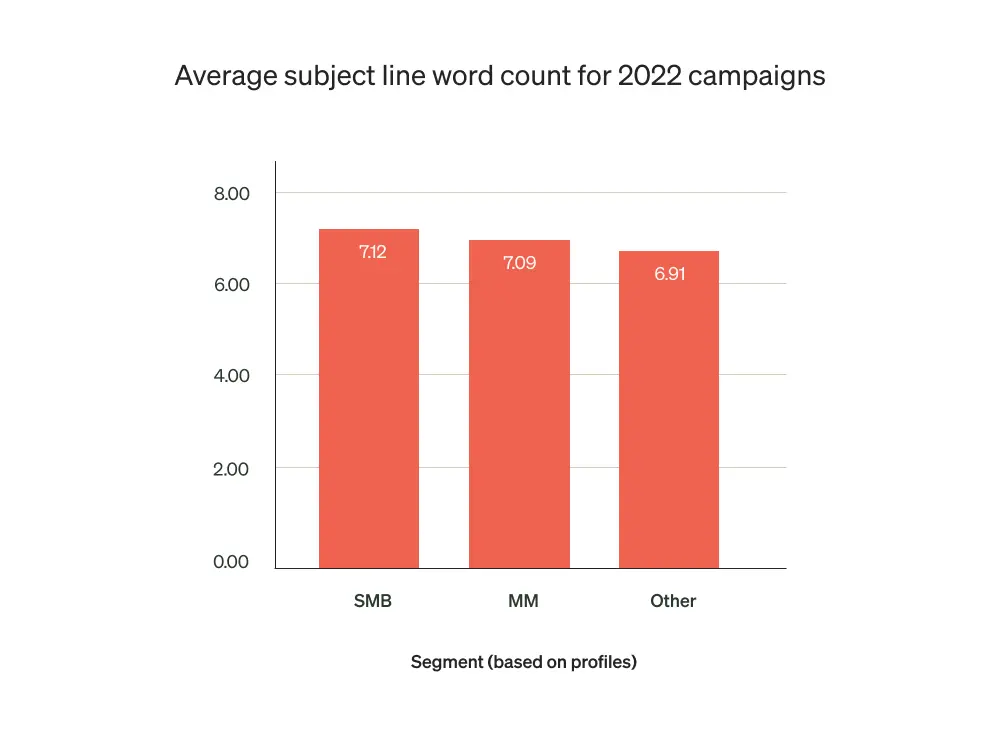
Dagne Dover, a brand that sells bags, sent this subject line that is just 4 words—only 14 characters. It stands out in an inbox, not only because it’s shorter than other emails, but also because it’s so concise and direct.
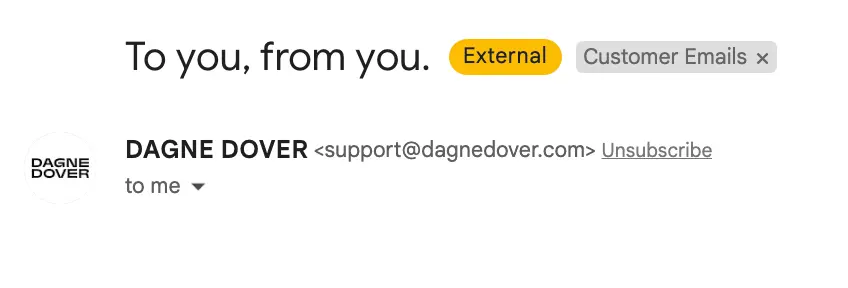
Cassie Benjamin, email and SMS channel manager at Tadpull, points out that a subject line that may read well on a desktop might get cut off in mobile inboxes.
“It’s always a good idea to view your subject lines on both desktop and mobile during your testing process,” she shares. “Use a shorter copy to ensure your enticing subject line doesn’t lose its effect on mobile.”
Use shorter copy to ensure your enticing subject line doesn’t lose its effect on mobile.
3. Communicate urgency—and FOMO—in your subject lines
The fear of missing out is one phenomenon that can drive customers to act quickly. It’s also a great hook for creating a catchy email subject line.
If you’re looking for a way to get people to act, create a sense of urgency. A great example is promoting a sale and reminding customers of a discount that’s about to end.
Creating a limited-time offer for a specific event or holiday can help you boost email open rates.
Klaviyo research found that subject lines that contain a word with all caps or language like “important” or “attention” earn higher open rates.
Similar to personalisation, bigger companies use all caps to convey urgency slightly more frequently than small-midsized businesses.
The key is to use only one word in all caps—and not to overdo it.
About 30% of email subject lines put at least one word in all caps, and about 1% of subject lines use urgent language.
Skincare brand Beekman 1802 communicates urgency with this subject line beginning “LAST CALL.”


Be careful that the urgency and FOMO you communicate don’t use email spam trigger words—words and phrases that, when included in your company’s emails, can result in them ending up in your recipient’s spam folder and negatively affect your email deliverability.
Some brands communicate urgency way too…loudly. Several words in all caps, too much explanation, or simply too many characters in a subject line can turn off just about any reader, let alone someone with inbox fatigue.
And consider how these subject lines look within an inbox.
Too many emojis, harsh colours, all caps—copy that can feel manipulative, like Are these the CAMPING COTS you wanted?
It’s too easy to move them to the trash or ignore them altogether.

4. Evoke a sense of curiosity in your headlines
Humans have a natural impulse to investigate, observe, and gather information. Teaser-style subject lines can leverage that natural curiosity and encourage customers to open your email just to find out what’s inside.
Curiosity is especially important to evoke if you’re hyping a new product, collection, or campaign that hasn’t launched yet. Sparking your audience’s interest before they understand the benefits of your product or service is key.
Use curiosity as much as possible—it’s one of the greatest emotional drivers humans have.
“Use curiosity as much as possible—it’s one of the greatest emotional drivers humans have,” says email marketer Chase Dimond on Twitter. “Do your best to create as much of it as you can in your subject lines. Instead of a subject line like, ‘One doctor’s tip for better health,’ use something like, ‘Why America’s #1 doctor says do NOT eat broccoli.’”
Fragrance brand Dossier evokes curiosity well with this simple, clear subject line.


Asking questions urges readers to open the email and find out the answer. It’s another form of curiosity and tapping into our information-seeking brains.
If you use this tactic, make sure to ask interesting questions to pique the recipient’s interest.
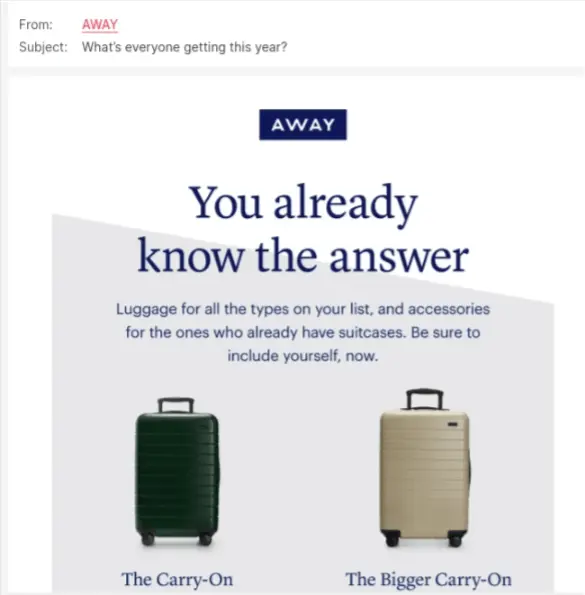
Just remember: By including a question in the subject line, you’re setting an expectation. Be sure to provide the answers the reader is looking for in your email body.
5. Make your subject lines conversational
A conversational and friendly tone of voice is far better than a robotic statement in the context of email subject lines. People tend to pay more attention when you talk directly to them.
Ben Zettler, digital marketing and ecommerce consultant, says, “Keep email subject lines concise. Ask questions. Be conversational and relatable.”
A good rule of thumb when writing an email subject line is to imagine you’re writing to a close friend. If you wouldn’t send it to your friend, it’s probably better to avoid it altogether.
Focus on your customers rather than your brand.
“My only advice for email subject lines is to think of them as starting a conversation rather than making an announcement,” suggests Samar Owais, a SaaS + ecommerce email strategist and copywriter, on Twitter. “Focus on your customers rather than your brand. Ask yourself, ‘Why should they care?’”
Adam Kitchen, CEO of Magnet Monster, encourages pushing the envelope. “Inject a dash of humour,” he suggests. “Throw your customers a curveball and use curiosity as the reason to open.”
Skincare brand Drunk Elephant is conversational, friendly, and even quirky in this subject line: “Resolution, schmesolution.”


6. Consider the context for every email subject line
Imagine if customers had a dedicated inbox just for your emails. Sounds great, right?
Unfortunately, this is far from reality—which is why you should consider every other aspect that might affect the performance of your emails.
“Consider the context,” says Nikki Elbaz, an email copywriter. “By context, I mean the inbox. What kinds of emails does your subscriber usually receive? Will emojis/questions/whatever style subject lines you’re writing stand out or blend in?”
Supply sent this cheeky subject line around BFCM, making good use of an emoji.
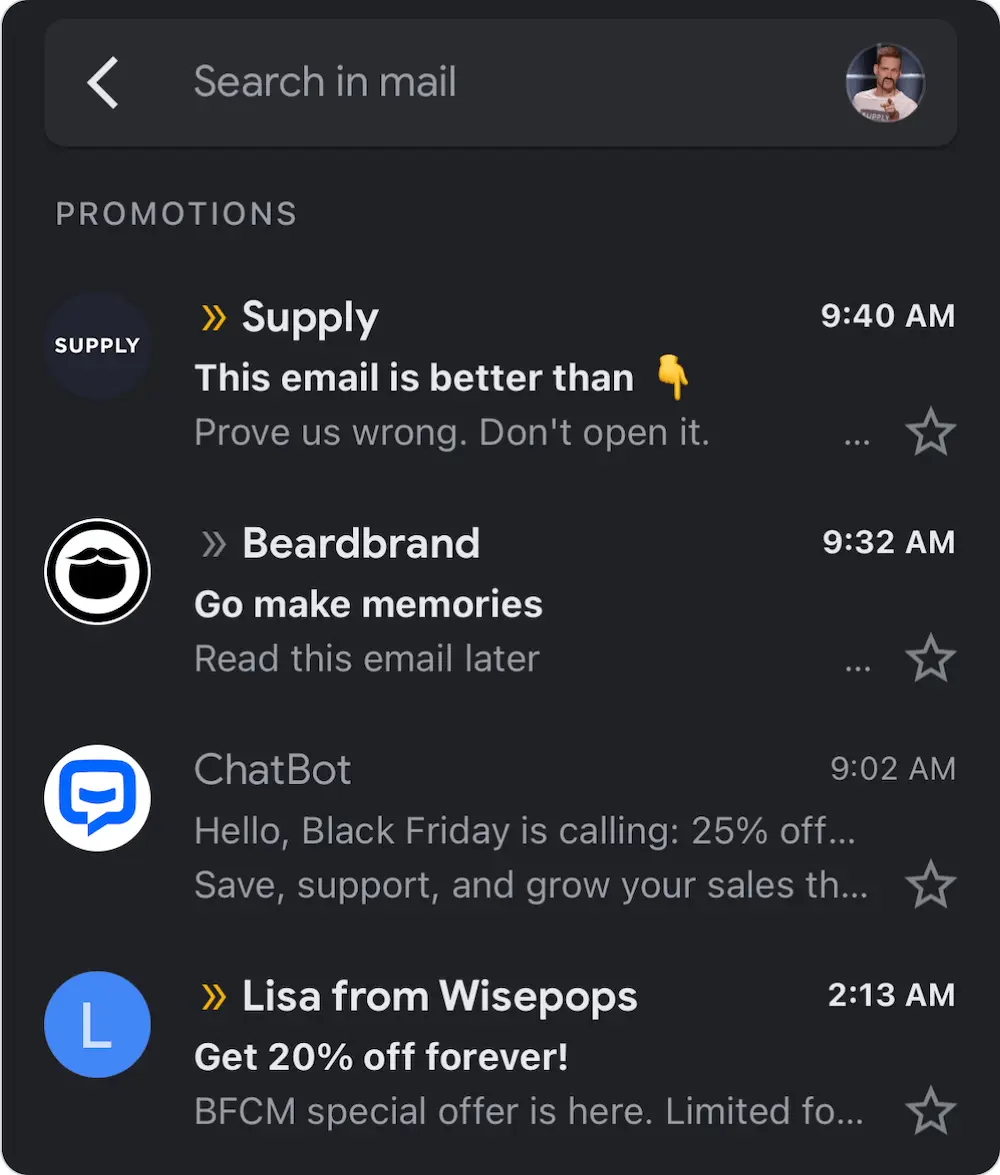
They’ve considered the context of the moment:
- Their email will likely end up in the promotions tab.
- They’ll be in a view full of emails from other brands offering discounts for the holiday.
- If they want their subscribers to open their email, it’s got to stand out.
Ask yourself: What day are you sending the email, and at what time? Study your email sends and open rates over time to see when they peak. Klaviyo’s Smart Send Times makes figuring this out super simple.
Additionally, think about what holidays are closest, too, to see if you can attach your promotion to an upcoming one. Seasonal and holiday emails are often some of the highest-performing email campaigns in terms of click rates and conversion rates because they’re some of the most timely communications consumers receive from brands.
7. Be strategic about including an offer in the subject line heading
When you have a specific offer for your customers, including it in the subject line is a smart way to increase your conversion rate.
Being straightforward and telling customers what they can expect inside the email can help you reach a high-intent audience.
Women’s clothing label Good American sent this email with the subject line “The Denim You Need, Only $99.”
If you’re offering a big promotion, saying so in the subject line is a great way to pique their interest.

Alternatively, consider a different kind of “discount,” such as a free gift with purchase or free shipping.
In this email, headwear brand Neff includes an enticing offer to increase average order value—all in under 9 words, including numbers and emojis.


8. Test emojis, but don’t overdo it
If you’re trying to stand out in a crowded inbox, you might think emojis would be an effective way to get noticed.
But don’t let your trigger finger get too itchy: Our research found that emoji usage is actually quite popular. Around 40% of subject lines use an emoji.
That means you might actually be blending in rather than standing out by inserting that melting face or a heart emoji.
In fact, we found that subject lines with emojis perform slightly worse than those without them.
Want to slash your open rates altogether? Stuff your subject line with emojis.
Recent Klaviyo data showed that open rates fall as the number of emojis increases. The same is true for the number of exclamation points and question marks.

Here are some quick tips for using emojis in subject lines:
- Don’t use more than one.
- Use emojis to amplify the message, not replace words.
- Remember that the goal of the subject line is to deliver a clear message. If an emoji helps you do that, go for it.
The Honest Company, a baby, beauty, and cleaning supply brand, sticks to all those best practices in this email subject line.

Tip: Don’t forget that emojis show up differently depending on the operating system your subscriber is using, so make sure to A/B test across channels and devices.
9. Preview text is important real estate—use it
We can’t talk about subject line best practices without mentioning the importance of preview text.

You can use the preview text section to capture the reader’s attention and give them a sneak peek into your email. If you don’t set the preview text, the email client will automatically use the first sentence of your email copy, wasting an opportunity to drive opens.
Digital marketing expert Abby Siciliano emphasises the importance of preview text. “Leverage the pre-header text area to elaborate on the story you’re telling,” she says.
The amount of text that shows up depends on the email client and the device the customer uses to check the email, so be sure to always test email subject lines before sending.
11 great email subject line examples—and why they work
To help you create effective email subject lines, we’ve dissected hundreds of emails from some of the leading DTC and retail businesses.
Note that what is email subject line best practice for one brand will be different for another.
1. Atoms creates an emotional response in its emails
Subject line: Your Dad is the Greatest
Why it works: Evokes emotions and creates an emotional response
The direct-to-consumer footwear brand Atoms sent an email for Father’s Day with a short and effective subject line, “Your Dad is the Greatest.” The strong personal appeal is designed to create an emotional response, and it’s often used as a marketing tactic to drive results.
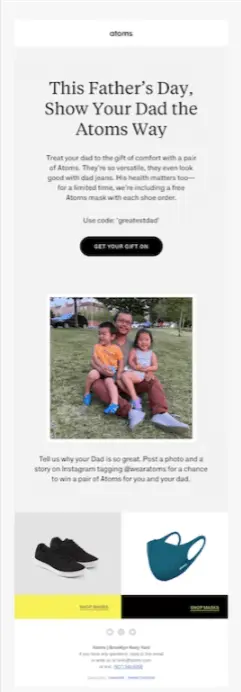
2. Caraway triggers a user’s curiosity through its marketing
Subject line: Are You Cooking With Toxins?
Why it works: Asks questions and triggers curiosity
The Instagram-famous cookware brand Caraway uses questions to trigger readers to open their email newsletters. As more people focus on taking care of their health than ever before, creating curiosity by discussing important topics such as possible threats by cooking with toxic cookware can boost open rates and bring more sales.
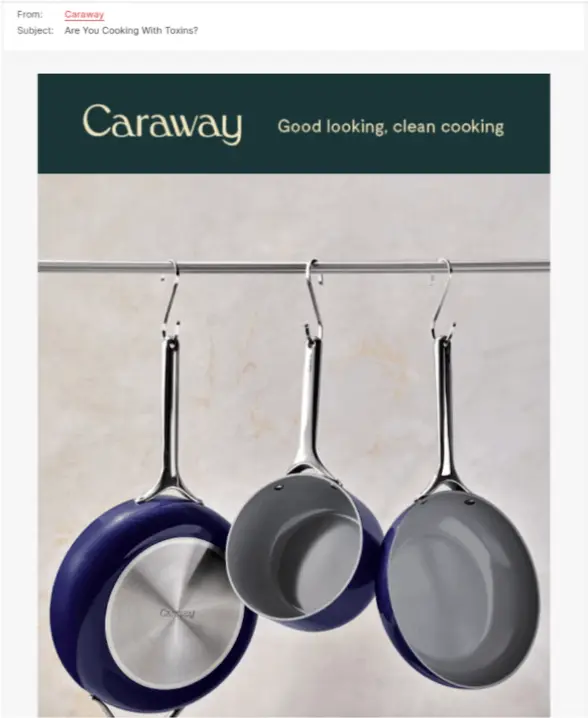
3. BK Beauty uses caps + emojis sparingly
Subject line: Travel Set REVIEWS are in…✈️
Preview text: “Whether you travel or not this set is absolute perfection!” —Terry V.
Why it works: The brand puts just one word in all caps, drawing the reader’s eye to it, even if they can only scan the subject line.
BK Beauty also makes great use of the preview text, including social proof of how much value their products bring to their customers.
These choices earned the brand a high open rate.

4. Reverie implies they have the information we need
Subject line: Are you washing your hair properly?
Preview text: How to do it right
Why it works: This subject line sparks curiosity through an information gap.
Reverie earned a high open rate with this subject line by implying that the email had something to teach the reader.
Toccara Karizma, CEO of Karizma marketing, says “Solving a pain point in your subject line can work well to encourage email opens.”

5. Fenty Beauty offers a sense of urgency—and a discount
Subject line: LAST CHANCE! Enjoy 25% OFF
Why it works: This email from Fenty Beauty is a great example of how to use all caps and punctuation marks without overdoing it. The cosmetics brand uses a combination of capital letters and sentence case formatting to highlight the urgency of the time-limited sale, while also showing the offer in the subject line so customers know what to expect.
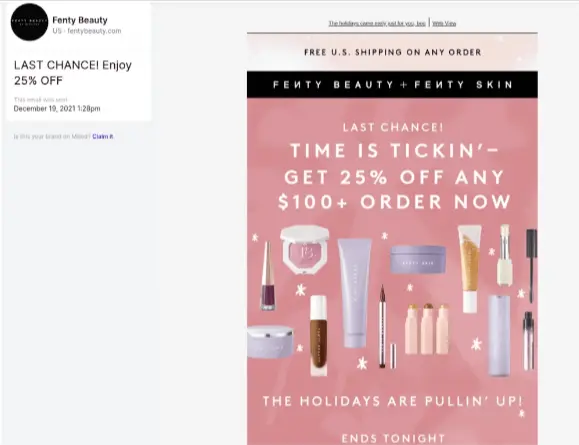
6. Chubbies targets its athletic audience
Subject line: Your new gym outfit
Why it works: If you’re a gym fanatic or you’ve been thinking of going to the gym, you can’t resist a subject line that teases “Your new gym outfit.” Premium apparel brand Chubbies targets a specific high-intent audience and makes it irresistible not to check what your next gym outfit might look like.
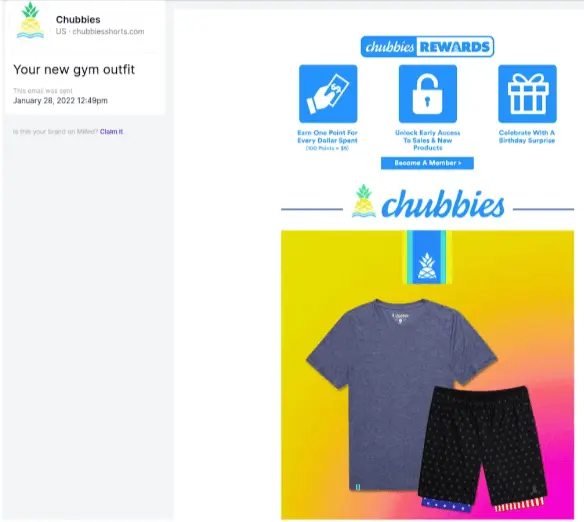
7. House Of Harlow 1960 creates FOMO
Subject line: Our most popular necklace is back in stock!
Why it works: If something goes out of stock quickly, it must be good, right? A subject line that says, “Our most popular necklace is back in stock!” makes customers want to check it out immediately. House Of Harlow 1960 is a well-known jewellery brand that uses this tactic to inform customers when a bestseller is available again.
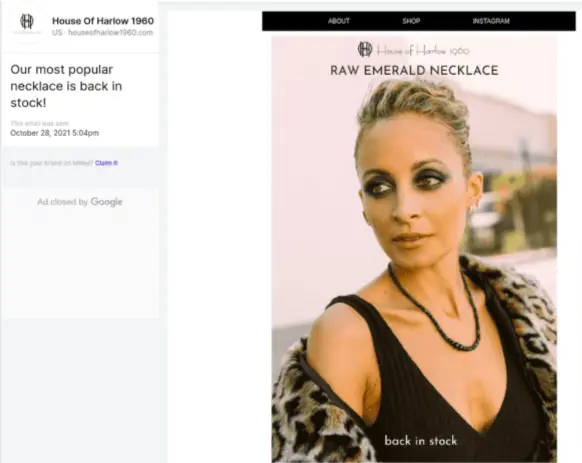
8. Natori gives customers a special offer in their subject line
Subject line: Express Delivery For V-Day
Why it works: Finding the right gift is always a challenge, and getting it on time during peak season becomes even more daunting. Luxury clothing and lingerie brand Natori sends this special offer for limited-time orders with express delivery for Valentine’s Day, urging customers to act quickly.
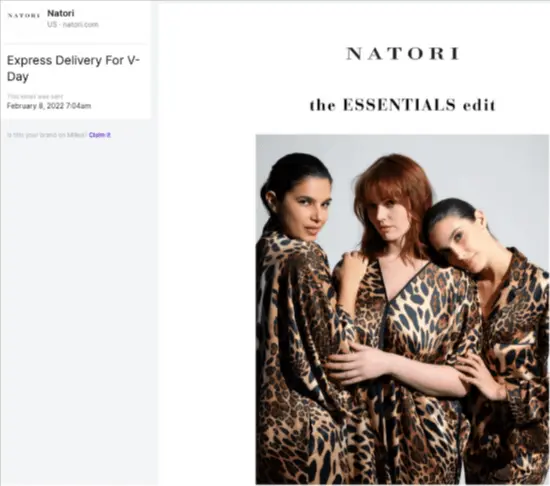
9. Kylie Cosmetics gives a free gift offer
Subject line: Buy a Lip Kit, get a FREE gift!
Why it works: Offering a free gift with purchase is one of the oldest marketing tactics in the book—and it still works! If you can incentivise customers with a gift, use that trigger in the email subject line to boost open rates and ultimately increase sales.
In this email, Kylie Cosmetics uses this tactic to sell more lip kits.
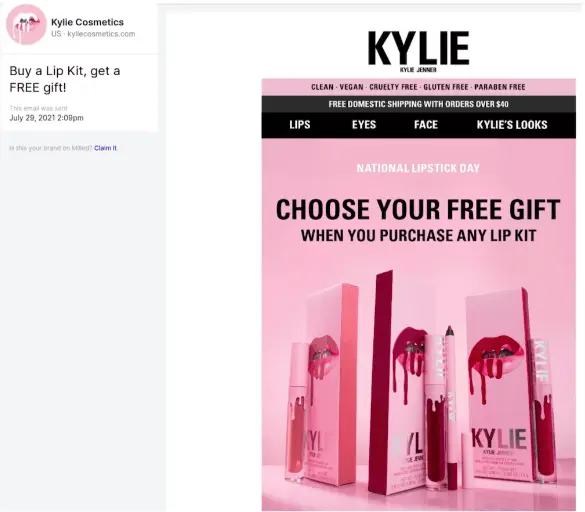
10. Lively uses UGC in the subject
Subject line: “I just did a yoga workout; the ladies stayed in their seats the entire time…”
Why it works: Uses customer review in the subject line
Using customer reviews as an email subject line is a powerful storytelling mechanism that urges readers to discover the whole story. Lingerie brand LIVELY experiments with different types of subject lines, using the power of customer reviews to spice up their subject lines with storytelling, credibility, and social proof.
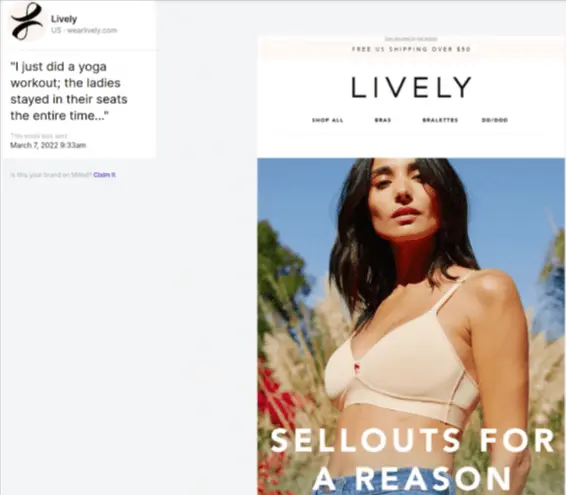
11. Tatcha promises customers results
Subject line: See instant results with The Rice Wash
Why it works: Customers with a problem to solve expect a brand to reassure them of the results they want. Be careful, here: If you decide to make a promise, make sure to stick to it.
With this email, luxury beauty brand Tatcha uses the power of a promise to encourage customers to try their product.

Klaviyo’s AI-powered subject line assistant: let us do the work for you
During a time of economic uncertainty, plenty of marketing teams are lean.
The copywriters on your team will be the first ones to tell you how much time and energy it takes to come up with the best subject lines that raise open and click-through rates.
Klaviyo’s AI-powered subject line assistant can take a lot of that work off their plates, freeing them up for deeper creative work.
With Klaviyo’s subject line assistant, it’s easy to generate a subject line that’s customised based on your brand voice and what you want this message to say.
The feature works for both campaigns and flows, and you can generate as many subject lines as you want until you find the one that works best with your email.
After you send a few campaigns, visit the analyse tab to see your best-performing subject lines and get a better understanding of what’s driving your audience to open your emails.
If your team wants to use the subject line assistant while simultaneously improving your original subject lines, you can see tips on drafting original subject lines, including examples that reflect best practices.

Ready to stand out with email subject lines that earn clicks?
Writing good email subject lines is half science, half art. The only way to improve is to test, optimise, and repeat.
The good news is that following successful email templates and best practices from the industry can help you craft compelling and click-worthy email subject lines.
And if you’ve made it this far, you know your subject lines are a gateway to a conversation with your customers that’s free of the pressure and whims of algorithms.
Email subject line examples FAQs
What should I include in the cold email subject line?
A cold email subject line should be short and to the point. The goal is to catch the recipient’s attention, and by making it short and sweet, you are more likely to invoke curiosity and motivate them to open the email they received from someone for the first time.
How to write a welcome email subject line?
Your welcome emails should be as personalised as possible, which also applies to the subject line. The best way to do so is to include the recipient’s name and, in that way, show the email is really for them and that you are ready to make the actual connection.
How do you grab attention in an email subject line without making it too spammy?
Brief and direct email subject lines are the best way to capture the recipient’s attention. Some of the key elements that businesses include in their professional emails to boost email open rates include:
- Company name
- Value proposition
- Reason for outreach
- Question
- Testimonial
- Call to action

Related content

Migrating to Klaviyo? Get expert insights on timing, tools, and tips to maximize your impact before Black Friday & Cyber Monday.
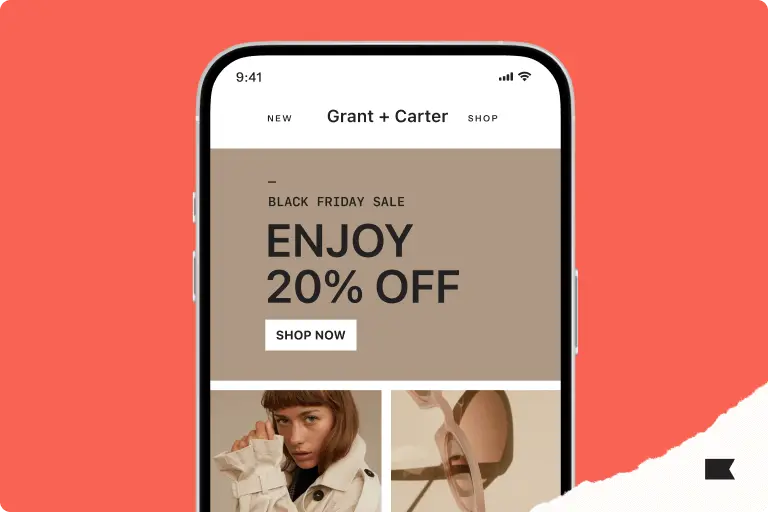
Explore Black Friday Cyber Monday email examples from top brands like Beyond Yoga and Twinings. Learn what worked, get expert tips, and see their successful results.

Learn more about the best time to send marketing emails. Pinpoint the optimal time to capture user attention to boost engagement and ROI.